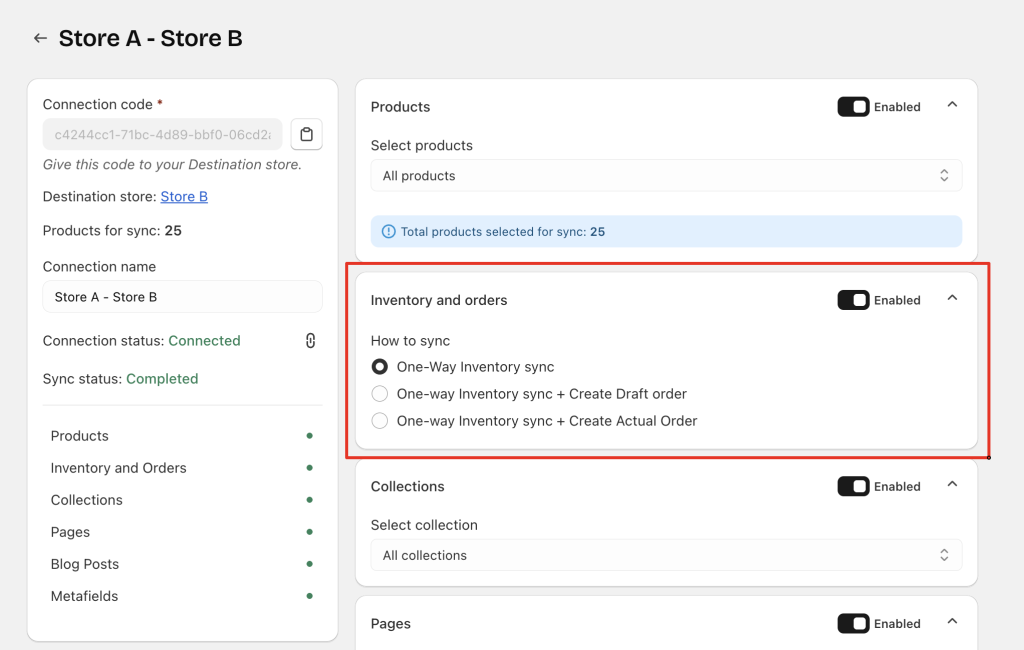Easify Inventory Sync always synchronizes inventory one-way, from the Source Store → Destination Store.
The only difference between the sync modes is what happens when the Destination Store receives a new order:
- No order is created in the Source Store
- A Draft order is created in the Source Store
- An Actual order is created in the Source Store
This guide explains each mode and when each is most suitable.
Source Store Setup #
The Source Store controls how inventory and optional order syncing behave.
You can choose between 3 modes:
- One-way Inventory sync
- One-way Inventory sync + Create Draft order
- One-way Inventory sync + Create Actual Order

1. One-way Inventory sync (Source → Destination) #
What it does
- All inventory updates flow only from the Source Store to the Destination Store.
- Inventory changes in the Destination Store do not sync back and do not affect the Source Store.
- The Source Store remains the single source of truth for all stock levels.
Typical use cases
- A business operating 1 central warehouse and several regional storefronts.
- Brands that manage stock only in one place but sell through multiple online stores.
- Multi-brand companies that want separate stores but unified inventory control.
Example
If the Source Store decreases from 50 → 40 units, the Destination Store updates to 40 automatically.
If inventory is edited manually in the Destination Store, it is not reflected in the Source Store.
2. One-way Inventory sync (Source → Destination) + Create Draft Order (Destination → Source) #
What it does
When a Destination Store receives an order for synced products:
- A Draft Order is created in the Source Store.
- Inventory continues syncing one-way (Source → Destination).
- The Source Store can review and convert the draft order before fulfillment.
Typical use cases
- Multiple storefronts but all fulfillment handled by one central warehouse.
- Businesses needing a simple way to pull orders back into the Source Store without immediately creating final orders.
- Situations where order approval or manual review is required before shipping.
Example
“Store A” (Destination) receives an order for Product X
→ A Draft Order appears in “Main Warehouse Store” (Source).
→ Staff reviews the order and converts it into a real order before fulfillment.
3. One-way Inventory sync (Source → Destination) + Create Actual Order (Destination → Source) #
What it does
When the Destination Store receives an order:
- An Actual Order (not a draft) is automatically created in the Source Store.
- Inventory still flows one-way (Source → Destination).
- Fulfillment can start immediately from the Source Store with no manual steps.
Typical use cases
- Businesses that fulfill all orders from a single warehouse.
- Merchants requiring automated, immediate order creation in the Source Store.
- Stores using fulfillment apps, accounting apps, or automation that rely on full Shopify orders.
Example
An order is placed in “International Store” (Destination)
→ A full Shopify order appears instantly in “Main Warehouse Store” (Source)
→ Fulfillment is processed from the Source Store immediately.
Destination Store Setup #
To ensure accurate inventory syncing, Location mapping must be configured.
Location Mapping Requirements
- 1 Source Store location must be mapped to 1 Destination Store location.
- Currently, each Source Store location can be mapped to only 1 Destination Store location.
- A single Source location cannot map to multiple Destination locations.
This prevents double-counting and ensures correct inventory distribution.

Quick Decision Summary #
Choose “One-way Inventory sync” if: #
- Each store fulfills its own orders
- Only inventory consistency is required
- No central fulfillment is needed
Choose “One-way Inventory sync + Create Draft order” if: #
- Central warehouse fulfillment is used
- Orders must be reviewed or modified before processing
- Teams need visibility but not full automation
Choose “One-way Inventory sync + Create Actual order” if: #
- All orders should be auto-routed to the Source Store for fulfillment
- Fully automated workflows are needed
- The Source Store handles logistics, shipping, and reporting
Need Assistance? #
If you run into any issues while syncing inventory or orders, our support team is always ready to help. Just message us through the 24/7 in-app live chat, we’ll assist you right away.